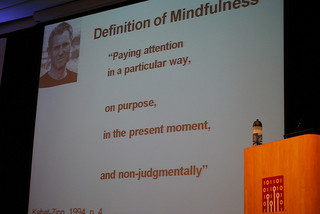|
|
|
Archive for December, 2013
Tuesday, December 17th, 2013

It’s almost 2014; a clean slate to do great stuff—but is it really?
Four years ago I identified one reason that change is so difficult, especially when it comes to tweaking/changing culture.
That reason is still with us and is just as much of a problem now as it was then, which means my post is as valid now as it was in 2009.
So, in the interests of a great 2014, here is a little bit of guidance on moving those changes along.
Ducks in a Row: Eliminating Cultural Stuff
I read a fascinating article today about Americans, their stuff and their penchant for storing it instead of getting rid of it.
“The US has 2.3 billion square feet of self-storage space. (The Self Storage Association notes that, with more than seven square feet for every man, woman and child, it’s now “physically possible that every American could stand — all at the same time — under the total canopy of self-storage roofing. …one out of every 10 households in the country rents a unit…”
According to Derek Naylor, president of the consultant group Storage Marketing Solutions, “Human laziness has always been a big friend of self-storage operators, because once they’re in, nobody likes to spend all day moving their stuff out of storage. As long as they can afford it, and feel psychologically that they can afford it, they’ll leave that stuff in there forever.”
I’ve said for years that people aren’t water faucets, able to turn off emotions and thoughts or change their MAP just because they change environments from home to work or vice versa.
Reading the article made me realize a hidden reason that makes changing culture so difficult.
It’s not just that the parts of the culture changes, but that the employees won’t let go of the parts that are changing or being replaced; instead they store them away to sort later.
But later never comes, so, like the stuff in the storage units, it sits in the back of their minds running up a bill that is paid in energy, focus and productivity.
As a result of the economy, many of the thousands of storage units that were in use for no other reason than laziness are being cleared out, or at least downsized, and the stuff gotten rid of.
Perhaps this is a good time to work with your employees to clean out their mental storage places; to purge the cultural residue and clutter that fills them up.
So clear out the rubbish, open the windows and let the fresh air flow through reenergizing everyone.
I’m not saying that change is easy, but I hope this bit of insight will help you fulfill your 2014 vision.
Flickr image credit: Guy Renard
Posted in Change, Culture, Ducks In A Row | No Comments »
Monday, December 16th, 2013
 Innovation is hot. You hear it everywhere; I even heard a pastor talking about how he “innovates his sermons.” Innovation is hot. You hear it everywhere; I even heard a pastor talking about how he “innovates his sermons.”
In 2007 I wrote that the word “leader” was being badly abused; five years later I added “entrepreneur” to the abuse list and today I’m officially adding “innovation.”
It has lost its meaning.
There was a time it was used sparingly and when it was used it referred to stuff like the printing press; steam engine, penicillin, transistor, computer, Internet.
Things that rocked our world.
These days innovation refers more to brand extensions and iterations.
New versions of old stuff are termed innovation to a ridiculous degree—Kellogg CEO John Bryant used the i-word when talking about the company’s new Pop-Tart flavor.
I’m not saying the i-word shouldn’t be used more broadly, since it also signals both a goal and a special type of MAP.
Let’s just agree to limit its use to the appropriate, as opposed to the ludicrous.
Image credit: sign generator
Posted in Communication | 1 Comment »
Friday, December 13th, 2013
A Friday series exploring Startups and the people who make them go. Read all If the Shoe Fits posts here

Well, actually, it was a shared 1st place with the Garage.com conference I went to in 2000 and met Guy Kawasaki and Bill Reichert who funded my company based on the impromptu pitch I did to them at the conference.
However, I am writing now about the last day of the Lean Startup Conference in San Francisco. A fantastic last day.
It completely reinforced what I wrote yesterday, that this has been the most practical and useful conference I’ve been to as a startup founder.
Even though I’ve done several startups and had successful exits on three, and been on the other side of the table as an institutional investor in startups, it was astounding how much I learned that was useful.
I really wish that this conference had existed 15 years ago when I got started in the startup business!
In the morning I went to a seminar led by Ash Maurya, author of the book “Running Lean,” called Innovation Accounting: A Blueprint for Defining, Measuring, and Communicating Progress With Internal and External Stakeholders.
In addition to Ash being a good presenter, every minute and every slide he went through was deep learning in how to get the operational aspects of a startup up and running around a new product.
In fact, it was a systematic methodology of building new products that I wish had been available for my past ventures. Everyone who is in the process of creating a new product, especially a software product, should read Ash’ book and participate in one of his practical seminars.
The afternoon session was called Science of Pricing: Tools to Optimize Price Without Sacrificing Conversions and was led by Justin Wilcox.
I have yet to experience a more dynamic, fun and practical seminar leader. In building a startup or product, one of the core challenges is how to price the product to get maximum conversions to sales at the highest possible price.
What Justin did was lead us through a hands-on session of how to accomplish this and got us actually doing a practical test on several products (after dividing us into teams, each testing pricing on one product) focusing on how to price them and pinpoint the optimal price to sales ratio.
Justin and his team are experts well worth consulting with to get this right. It is guaranteed to earn you a lot more money and save you from pain.
To be honest, based on past conferences I’ve attended, I had low expectations arriving at the Lean Startup Conference. And as you have read, I’ve been totally blown away by what I experienced.
If you are an entrepreneur, even an experienced one, you must beg borrow or steal to get the opportunity to go.
Don’t miss this learning opportunity – for me. It would have saved me millions of dollars in cash, several years of time, and lots of sleepless nights and struggles at home and at work.
I have one criticism about the conference – please choose better names for the sessions.
The naming convention was horrible and made it difficult to compare notes with fellow conference participants of what they had experienced since none of us could remember the names of the sessions.
Thank you, Lean Startup Conference – I’ll see you next year!
Image credit: HikingArtist
Posted in Entrepreneurs, If the Shoe Fits | 3 Comments »
Thursday, December 12th, 2013
 I am seldom effusive in my praise of any conference I’ve attended. I am seldom effusive in my praise of any conference I’ve attended.
Most conferences bring in speakers who simply recycle the presentations they’ve done for many other audiences, people clap and get a momentary high from associating with others and hearing engaging speakers. But a few days later, it’s all gone.
This is even truer for conferences dealing with the startup ecosystem.
These are focused on getting already poor (sometimes starving) entrepreneurs to pay hundreds (sometimes thousands) of dollars to go and listen to the same stuff. Often the carrot is meeting angel and VC investors, but very few people I’ve encountered (if any) ever received an investment based on meeting an investor at one of these conferences.
The Lean Startup Conference is very different, in fact, I cannot be more enthusiastic.
This is one of the few conferences I’ve attended as a company founder and serial entrepreneur that has provided practical knowledge that I can use in building my company.
Low bullshit factor, lots and lots of case studies related to company problems and solutions, great strategic insight and golden nuggets strewn through all the speakers’ talks. In addition, the conference was well organized and the logistics worked flawlessly.
The audience was very diverse – race, geographical origin, profession (software engineer, bioengineer, marketing, C-level execs, tech support, etc.), size of company (everything from pre-revenue startups to major companies like GE and Intuit), and industry (pharma, tech, government, automotive…).
It is doubly impressive that they managed to pull off a conference that worked for such diversity.
Maybe there is excellence in the conference business after all.
Posted in Entrepreneurs | 1 Comment »
Wednesday, December 11th, 2013
No question about it, I am a Malcolm Gladwell fan and his new book, David and Goliath: Underdogs, Misfits, and the Art of Battling Giants, sounds fascinating.
I can’t comment further, since I haven’t had a chance to read it, but two points from this interview stood out among many others.
First, I have always believed the road to Hell was paved with bad assumptions and Gladwell seems to see that also.
“We are misled by the narrowness of our assumptions about what constitutes an advantage in any given situation.”
Second, his comments regarding leaders and managers score a perfect bulls-eye, as do his thoughts on why hiring a good fit is so difficult.
I realize now that an effective leader or manager can come in a virtually infinite number of forms. I have way more respect for the heterogeneity of excellence. That took a long time because it is so tempting to try and paint a very specific picture of what you think effective leadership is or what an effective organization looks like. The older I get and the more I see, I realize high performers of one sort or another have certain things in common. But they are almost more distinguished by what they don’t have in common than what they do.
Understanding fit is a much more important issue than defining the characteristics of excellence — understanding the combination of individual and organization and why at different points in your life cycle you might want a very, very different kind of person. The purest example of this is in sports, where the notion of fit between the athletes that you have and the coach that you hire is only occasionally considered. You will read that they brought in a coach whose plotting style is ill-suited to the athletes that he has. And then you wonder: Why did they bring in that coach? Why do a plotting style if no one on your team wants to play the plotting style? It is interesting how hard that notion is. Maybe it’s because it renders the task of defining what you want a lot more complicated, and we would rather not deal with that.
Below is the video interview or, if you don’t have time to watch, you can read the edited transcript.
Posted in Change, Personal Growth | No Comments »
Tuesday, December 10th, 2013

What’s wrong with our so-called leaders?
I finally figured it out.
They live in an alternate reality.
Not all of them, but too many.
And I don’t have to go to Washington (DC) to see them in action.
I can stay home in (southwest) Washington (State)—Clark County, to be exact (nowhere near Seattle.)
We have a county commissioner named David Madore who says he doesn’t know how someone can have a “meaningful” life on $50,000 a year.
First you have to understand Clark County reality.
According to the American FactFinder, a report from the U.S. Census Bureau, data from 2007-2011 indicates the median earning for a single worker in Clark County is $32,337.
Scott Bailey, regional labor economist for the Washington state Employment Security Department, says if you take out all of the seasonal workers from that number, it jumps to about $46,000 or $47,000. The median for men being $51,502 per year, and $40,023 per year for women.
Bailey says more than half the individuals in the county make less than $51,556.
Therefore, substantially more than half of us don’t live meaningful lives.
(New York City, at a median $50,895, is slightly lower, but with a far higher number of peole whose lives aren’t meaningful and those poor folks don’t even have someone to tell them.)
Obviously, Madore lives in an alternate reality.
As do most politicians, corporate chieftains, a good deal of Silicon Valley, Wall Street and others.
Flickr image credit: Jim Champion
Posted in Compensation, Ducks In A Row | No Comments »
Monday, December 9th, 2013

A few years ago I asked why companies thought they could cut pay, benefits and hours and still expect their workforce to stay engaged and give a damn about the company’s success.
The answer, of course, is they can’t and the employees don’t.
Even as they cut pay and hours, retailers that sell “value pricing” still expect people to buy.
A good example is Wal-Mart, long known as the poster child of low compensation and king of the part-time workforce.
But in earnings calls the blame is on the costs that are going up with no mention of wages going down.
“Their income is going down while food costs are not,” William S. Simon, chief executive of Wal-Mart, said of the company’s customer base. “Gas and energy prices, while they’re abating, I think they’re still eating up a big piece of the customer’s budget.”
And down it has gone.
Adjusted for inflation, the national minimum wage reached a peak in 1968 and has lost about 6 percent of buying power since it was last raised in 2009.
I sometimes think Henry Ford was the last executive who understood that you can’t run a consumer economy if the consumers aren’t paid enough to buy stuff.
Ford astonished the world in 1914 by offering a $5 per day wage ($110 today), which more than doubled the rate of most of his workers. (…) The move proved extremely profitable…
Obviously, Wal-Mart has never had an executive who understood that simple principle.
Congress doesn’t either.
Simon says income is going down, but apparently he can’t make the connection between that and his company’s actions.
Simon and his ilk know that people need disposable income to buy stuff, but for that to happen they need to stop treating their people as disposable.
Flickr image credit: Bernard Pollack
Posted in Compensation | 1 Comment »
Friday, December 6th, 2013
A Friday series exploring Startups and the people who make them go. Read all If the Shoe Fits posts here

The words of Jeffrey Wright should resonate with every entrepreneur who isn’t connected through past work experience or an “in” network that provides personal introductions to the investor community—because they are facing a long, cold trip on the road to funding and success.
Moreover, the wrong gender (female) and/or ethnicity (not white) create even greater challenges to be overcome.
“I don’t really consider myself a black man in Hollywood. I live in Brooklyn … and on purpose. At the most base level, what an actor represents to the film industry is an investment. Depending on the risk profile, an investor needs 1,000 reasons to commit and one reason not to. That means you’ve got to do more work on your own and that the machine is not going to necessarily do the blocking for you. The machine rarely accepted my code. That can be frustrating, but you just have to be aware.”
The quote was sent to me by KG Charles-Harris; I added the emphasis.
When I commented that it applied just as accurately to venture investors KG responded that that was why he liked it.
Granted, it’s not fair, or even defensible, but it is reality.
And while it’s great to work towards an ideal, I’ve always believed that you still have to function in the real world.
As Wright points out, the difficulties are great enough without exacerbating them by playing ostrich, pretending they aren’t there or will go away if you ignore them.
Image credit: HikingArtist
Posted in If the Shoe Fits, Personal Growth | No Comments »
Thursday, December 5th, 2013

Entrepreneurs are in love with their technology, whether it’s software, hardware, services, food, etc.
Doesn’t matter, given their druthers they would much prefer to tell you why the technology is so awesome and how it will change the world—or at least a part of it.
That’s OK when talking to another techie, but investors are far more interested in the market.
And, other than cutting-edge outliers, the market doesn’t really give a damn about the technology.
The market is strictly WIIFM or, as Asana cofounder Justin Rosenstein puts it,
“Ultimately everything else we do is essentially a means toward an end of providing the user with some experience. We are really constantly grounding the whole company in that empathy of realizing that all the work you’re doing is a means to an end in service of and dedication to other people, an act of service to help others.”
Asana’s numbers are impressive.
It was founded in 2008 (think Recession), exited beta in 2011 (three years), has over 50 employees and is used by hundreds of thousands of teams from the likes of Twitter, Foursquare, LinkedIn and dozens of others.
It has a valuation north of $300 million.
Asana accomplished all this with just $38.5 million in venture funding—a tiny number by today’s standards.
Read the interview of Rosenstein and cofounder Dustin Moskovitz and their use of mindfulness to create a culture that focused on customers.
Then evaluate the focus of your own culture.
Because no matter how cool your technology, it’s worthless if people don’t/won’t buy it.
Flickr image credit: cambodia4kidsorg
Posted in Culture, Entrepreneurs | 2 Comments »
Wednesday, December 4th, 2013
 Experts love to study the Millennials and make wonderful pronouncements across an entire generation. Experts love to study the Millennials and make wonderful pronouncements across an entire generation.
The latest research looks at what Gen Y wants from their career—meaning or happiness.
- Meaning our lives have purpose, value, impact and usually a feeling of being connected to a larger goal.
- Happiness is more self-directed with a laser focus on ‘me’.
In everyday terms you are a giver or a taker.
Those who reported having a meaningful life saw themselves as more other-oriented — by being, more specifically, a “giver.” People who said that doing things for others was important to them reported having more meaning in their lives. This was in stark contrast to those who reported having a happy life. Happiness was associated with being more self-oriented — by being a “taker.” … Having children, for instance, is associated with high meaning but lower happiness. Having children, for instance, is associated with high meaning but lower happiness.
Funny; the giver/taker label seems to fit every person I’ve ever met.
While I’m not a trained professional, I don’t see where they are mutually exclusive—children obviously provide meaning, but they also make most parents happy.
The problem Millennial studies have is the same as the studies of the Boomers, i.e., 80 million individuals make generalizations questionable; however, one point does make a lot of sense.
Millennials have been forced to reconsider what a successful life constitutes. By focusing on making a positive difference in the lives of others, rather than on more materialistic markers of success, they are setting themselves up for the meaningful life they yearn to have…
Yup; nothing like a crappy economy to undercut an entitled mindset.
Flickr image credit: One Way Stock
Posted in Motivation, Personal Growth | No Comments »
|
 Subscribe to
Subscribe to
MAPping Company Success
About Miki 
Clarify your exec summary, website, etc.
Have a quick question or just want to chat? Feel free to write or call me at 360.335.8054
The 12 Ingredients of a Fillable Req
CheatSheet for InterviewERS
CheatSheet for InterviewEEs™
Give your mind a rest. Here are 4 quick ways to get rid of kinks, break a logjam or juice your creativity!
Creative mousing
Bubblewrap!
Animal innovation
Brain teaser
The latest disaster is here at home; donate to the East Coast recovery efforts now!
Text REDCROSS to 90999 to make a $10 donation or call 00.733.2767. $10 really really does make a difference and you'll never miss it.
And always donate what you can whenever you can
The following accept cash and in-kind donations: Doctors Without Borders, UNICEF, Red Cross, World Food Program, Save the Children
*/
?>About Miki
About KG
Clarify your exec summary, website, marketing collateral, etc.
Have a question or just want to chat @ no cost? Feel free to write
Download useful assistance now.
Entrepreneurs face difficulties that are hard for most people to imagine, let alone understand. You can find anonymous help and connections that do understand at 7 cups of tea.
Crises never end.
$10 really does make a difference and you’ll never miss it,
while $10 a month has exponential power.
Always donate what you can whenever you can.
The following accept cash and in-kind donations:
|











 Experts love to study the Millennials and make wonderful pronouncements across an entire generation.
Experts love to study the Millennials and make wonderful pronouncements across an entire generation.
